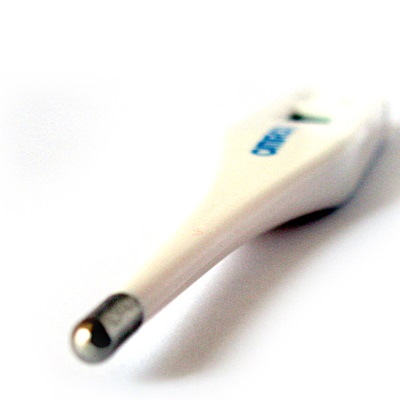 Fever is an elevation of the normal body temperature. It can be caused by an infection, though sometimes not. A normal body temperature can range from 97 degrees F to 99+ degrees F and varies from person to person. Oral temperatures above 99.6, or rectal temperature above 100.4 degrees F, are usually considered to be above normal in children. There may be various reasons why a child has a fever, but remember that fever in itself is not an illness, but only a symptom. The fever will fluctuate during the day, usually a little lower in the morning and rising during the afternoon or during play.
Fever is an elevation of the normal body temperature. It can be caused by an infection, though sometimes not. A normal body temperature can range from 97 degrees F to 99+ degrees F and varies from person to person. Oral temperatures above 99.6, or rectal temperature above 100.4 degrees F, are usually considered to be above normal in children. There may be various reasons why a child has a fever, but remember that fever in itself is not an illness, but only a symptom. The fever will fluctuate during the day, usually a little lower in the morning and rising during the afternoon or during play.
Most parents can tell if their child is warm by placing a hand over their forehead or a kiss on the brow, but it’s best to use a thermometer to get an accurate number in the event you need to call your physician. Back in my parenting days I used a glass mercury thermometer, which are now practically extinct. There are so many new options to try, so here are some basics about each.
The most common thermometer you can buy today is the digital one. They enclose electronic heat sensors inside that record the child’s body temperature. Digitals can be used in the mouth, armpit, or rectum. For babies, taking the temperature rectally is the most accurate. Older children and adults do well with oral readings with the armpit method the least accurate. Plan on having two digital thermometers in the house, one for oral and one for rectal. Never use the same device in both places. And with older children you can buy plastic sanitary sleeves to fit the thermometer if oral temperature taking is for several family members.
Ear thermometers come in second for popularity. They are also known as tympanic thermometers, which use an infrared ray to measure heat inside the ear. They are pretty accurate when positioned properly and give a quick reading. According to the Mayo Clinic, these thermometers are not the best for infants, due to an accumulation of earwax or a small, curved ear canal.
As a preschool teacher, I’ve used temperature strips on a child’s forehead if we suspected a fever. These contain liquid crystals that react to heat and change colors allowing us to read the body temperature. They are very easy to use and give you an idea if the child is ill, but are not the most accurate in numeric values.
Have you heard of a pacifier thermometer? When a baby sucks on the pacifier it records a peak temperature. The baby needs to hold the pacifier in his/her mouth for at least three to five minutes. This may not be easy if the child has nasal congestion. All in all, it’s a sneaky and easy way to check a young child’s temperature without the trauma.
The newest thermometer is the temporal artery version. You just swipe it across the forehead and the infrared scanner measures the temperature. These are costly, but by far the easiest way to check your youngster even when asleep.










